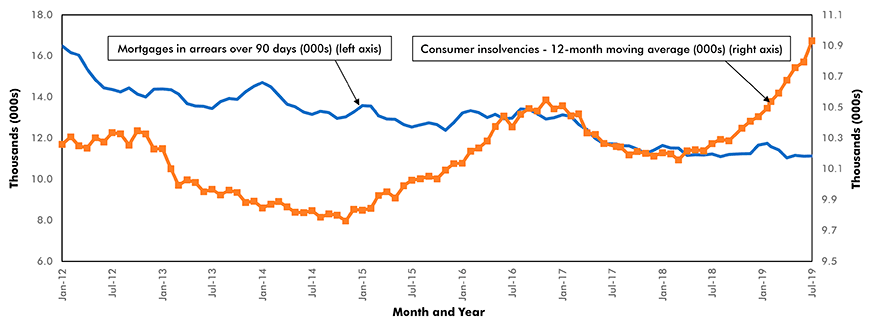Over the past year and a half, consumer insolvencies for the country as a whole have been trending higher despite the fact that Canada’s unemployment rate is close to the lowest it has been in almost fifty years, due to exceptionally strong employment growth.
Year-to-date (September) consumer insolvencies totalled 102,000, up 9.3% compared to the same period a year earlier. This relatively recent acceleration in consumer insolvencies is at odds with the recent trend in business insolvencies which has been trending steadily lower over the past eight years, despite the relatively fast growth of business credit. This divergence suggests that consumers are experiencing significantly more financial stress than are businesses.
A recent article in the Globe and Mail highlighted how several measures of consumer financial health have deteriorated over the past several years. First, fueled by a steady increase in both mortgage (+14.1%) and non-mortgage (+14.1%) borrowing, total interest paid by households in Canada has increased by 32% over the past three years. Reflecting this rise in interest payments, the debt-service-ratio, the percent of household income used to carry outstanding debt, now stands at 14.9 per-cent, its highest level in almost thirty years. Although consumer loan rates have moved up slightly over the past few quarters, the major contributor to the increase in the debt-service-ratio has been the growth of consumer borrowing.
Across the country, consumer insolvencies have exhibited double-digit percentage increases in Newfoundland and Labrador (+ 17%), Alberta (+15.1%), Manitoba (+13.5%) and New Brunswick (+10.4%). It is worth noting that consumer insolvencies exhibited an above (national) average increase of +15.3% in Ontario despite the province’s strong economic fundamentals and the well below national average consumer debt delinquency rate Equifax Canada reported for Q1/19. This apparent inconsistency appears to have been due, in large part, to the exceptionally strong growth of population in the province over the past year and a half. The higher rates of growth of insolvencies in the other provinces noted above are consistent with their higher delinquency rates and the fact that their unemployment rates are above the national average.
The rise in consumer insolvencies since mid-2018 provides clear evidence that consumers’ financial health has deteriorated due to their persisting excessive reliance on credit. Faced with a gradual uptrend in variable rate mortgage rates since mid-2018, there is also evidence that more highly leveraged homeowners are falling behind in their mortgage payments. According to Equifax Canada, mortgage delinquencies for the country were up by 4.1%y/y in Q1/2019. However, both Equifax and the Canadian Bankers Association (CBA) report that delinquencies and the percentage of mortgages more than 90 days in arrear remain at very low levels. According to the CBA, mortgage arrears in July stood at 0.23%, their lowest print in 29 years. Across the country, mortgage arrears are well below the national average in Ontario (0.09%) and British Columbia (0.14%) and above it in the Atlantic Provinces (0.45%), Manitoba (0.35%), Saskatchewan (0.85%), Alberta (0.50%) and Quebec (0.28%).
While many attribute the increase in insolvency to the very strong growth of debt service costs accompanied by subpar growth of wages, there is one factor which is frequently overlooked, i.e. taxes. According to the Fraser Institute’s Canadian Consumer Tax Index, which tracks the total tax bill of the average Canadian Family, the average Canadian family total tax bill increased by 4.3% last year, well ahead of the 3.5% increase in their average cash income. Indeed, over the past four years, the average Canadian family’s tax bill has risen by 11.9% while their income rose by 8.5%.
Looking forward, the fact that consumers are carrying very high levels of debt, coupled with their recent pattern of exceptionally low savings suggests that they are much more vulnerable to the effects of a loss of employment and/or an interest rate shock than they have been in the past. Having said this, a number of recent developments point to slower growth of insolvencies over the medium term.
First, full-time employment has exhibited strong (above 2% y/y) growth over the past five months that has been accompanied by the fastest year-over-year gains in weekly wages (October) since mid-2018. Second, over the past year, the growth of consumer credit has trended gradually lower and is currently (October) 2.9% y/y, its lowest rate of increase since mid-2016. Third, following the introduction of the mortgage stress test in 2018, borrowers had to jump a higher hurdle to qualify for a mortgage and are less likely to default in the event of an increase in mortgage rates.
John Clinkard has over 35 years’ experience as an economist in international, national and regional research and analysis with leading financial institutions and media outlets in Canada.
Consumer insolvencies and mortgages
more than 90 days in arrear

Chart: ConstructConnect – CanaData.











Recent Comments
comments for this post are closed